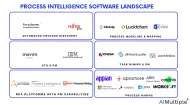Business Process Design in '24: 7 Best Practices
Process design refers to creating a process or a workflow for an organization from scratch. Process design can help businesses increase efficiency and customer satisfaction by maximizing resources, reducing costs and fostering communication and collaboration. However, it is often a mystery to business leaders how they can actually achieve a successful process design.
Therefore, in this article, we provide a list of 7 best practices to help you design your processes and accelerate your business.
1. Decide on the type of process to work on
Business analyst leaders should clarify the type of process which they want to design. Business processes usually consist of the following three types:
- Operational processes: These are the primary workflows starting with the first step until the realization of business outcome. Manufacturing and marketing a product are examples of operational processes.
- Supporting processes: These secondary are complementary to operational processes and help them to function smoothly. For example, employee on-boarding facilitates new employees to adapt quickly to their new working environment.
- Management processes: These are operational protocols in the company, helping assess the process performance and compliance.
Once decided on the process type, process analysts should next detect individual tasks relevant to the specific process, goal or outcome. Tasks and activities are important components of each method to design stable processes.
2. Identify responsible parties
Every process includes different departments or employees to execute certain tasks in the operational flow. The number of parties can vary based on the length and complexity of the process. Primary processes tend to be the most complex operations with several teams or departments included.
For example, Figure 1 below shows a manufacturing company’s order to delivery process. Such a process includes sales, manufacturers, logistics, IT and various employees.

Mitigate hand-offs risks
While allocating responsibilities across units and employees, it is crucial to consider hand-offs. Hand-offs in a business context connect dots between people, systems and departments to pass information, responsibility or personnel from one unit to another. When hand-offs are not clear, it will hinder smooth process execution, leading to failures and delays.
Quick tip: One way to identify responsible employees, teams, and/or departments is to use process modeling tools and outline the workflow with diagrams.
3. Take a customer-first approach
While designing a process, it is always crucial to consider the customer’s perspective. The analysts always question if the activities and tasks satisfy customer needs and convince them to pay for the service or product.
For example, a bank has a lengthy approval process it has to identify the pain points causing the delays in the process and improve them areas for customer satisfaction.
Quick tip: Analysts can leverage CRM data and customer feedback data to determine areas that require improvement and practices that customers rate the highest. Analyzing customer data would point the right directions and save time to figure which processes can be improved.
4. Keep an eye on automation
While designing processes, analysts should consider if the process contains tasks or activities that are repetitive or time-consuming due to their manual nature. Such processes lead to inefficiency and require automation. Automating redundant tasks enables employees to save time for more value-added activities, improving employee engagement and process performance.
Quick tip: Process mining and a digital twin of an organization (DTOs) can facilitate automation implementation journey for businesses by pinpointing the tasks and operations that require RPA, calculating ROI and managing the transformation project.
5. Standardize and incorporate compliance
Another must in process design is remembering best practices and instructions about the process and aligning company’s operations with them. For instance, in many cases, business processes need to comply with the region’s external rules and regulations.
Such standardization will allow the business leaders to achieve consistent and clear processes across their business. Also, they will ensure compliance with external rules (i.e., tax regulation or protocols). As a result, the confusion that might have previously gripped employees as to whether their tasks are regulatory-compliant might subside. Thus, the organization will perform faster and better with more predictable results.
Quick tip: Process intelligence tools such as process modeling and process mining are helpful to standardize processes. Specifically, process mining can ensure compliance with conformance checks and automated root-cause analysis capabilities. Understand differences between process modeling and process mining with our in-depth comparison article.
6. Visualize processes
Process maps and diagrams help analysts understand the full workflow of the operations and identify tasks, activities, responsible parties and optimal ways of executing the process. Visuals also serve as training materials which help employees understand the entire workflow and their responsibilities better. Different teams and units can communicate through visuals, fostering collaboration across the entire organization.
Quick tip: Analysts can benefit from several process intelligence and simulation such as process mapping, modeling, mining and DTOs to visualize the operations.
7. Set metrics and measures
Business analysts should see relevant metrics and performance measures to establish accurate and measurable processes. They should track the important points (i.e., internal request at back-office once customer made an order), obtains results and turn these findings into a quantifiable performance measure, which are known as KPIs.
Once the process is implemented, analysts can use these KPIs to assess process performance, identify bottlenecks, and determine where further improvements are required.
Quick tip: Process mining architecture includes process performance analysis capabilities allowing users to measure the performance of their processes with metrics. Users can also find errors and the root-causes behind the errors to modify them.
Further Reading
If you want to learn more on process improvement, intelligence and innovation to accelerate your business, read our in-depth guides:
- Pair Methodology with Technology for Process Improvement
- What is Process Intelligence & 5 Reasons Why It Matters?
- Process Innovation & 3 Best Practices to Achieve it
If you want to design your processes but do not know know which tool to choose, check out our data-driven vendor lists for process mining and modeling.
Explore top process management and improvement technologies to design your business processes, such as:
- Workflow management software
- Business process management software
- Low-code/No-code development platform
- Onboarding software
- Process mining
- Business process automation software
If you want to assess different vendors with a transparent methodology yourself by downloading our checklist:
Also, feel free to contact us if you need more help:



Comments
Your email address will not be published. All fields are required.